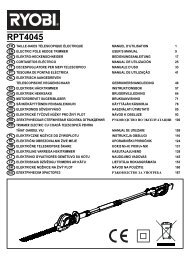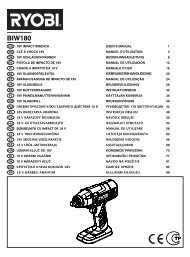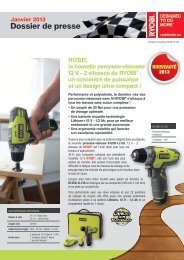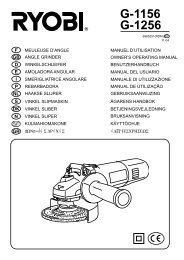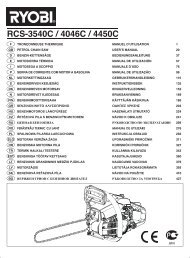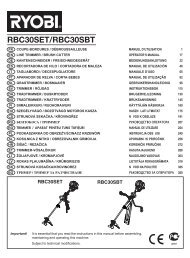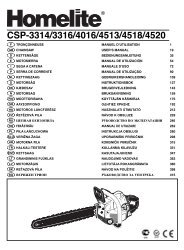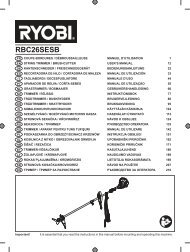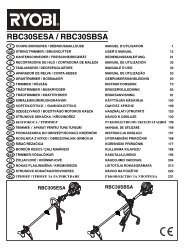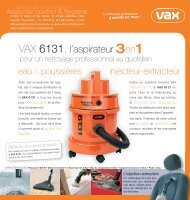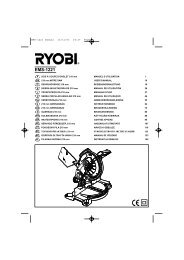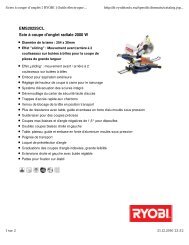You also want an ePaper? Increase the reach of your titles
YUMPU automatically turns print PDFs into web optimized ePapers that Google loves.
23 PM<br />
GB<br />
FR DE ES IT NL PT DK SE FI NO RU PL CZ HU RO LV LT EE HR SI SK GR TR<br />
SPECIFIC SAFETY RULES<br />
DANGER! Keep hands away from cutting area and<br />
the blade. Keep your second hand on auxiliary<br />
handle, or motor housing. If both hands are holding<br />
the saw, they cannot be cut by the blade.<br />
Do not reach underneath the workpiece. The<br />
guard cannot protect you from the blade below the<br />
workpiece.<br />
Adjust the cutting depth to the thickness of the<br />
workpiece. Less than a full tooth of the blade teeth<br />
should be visible below the workpiece.<br />
Never hold piece being cut in your hands or across<br />
your leg. Secure the workpiece to a stable platform.<br />
It is important to support the work properly to minimize<br />
body exposure, blade binding, or loss of control.<br />
Hold power tool by insulated gripping surfaces<br />
when performing an operation where the cutting<br />
tool may contact hidden wiring or its own cord.<br />
Contact with a "live" wire will also make exposed metal<br />
parts of the power tool "live" and shock the operator.<br />
When ripping always use a rip fence or straight<br />
edge guide. This improves the accuracy of cut and<br />
reduces the chance of blade binding.<br />
Always use blades with correct size and shape<br />
(diamond versus round) of arbour holes. Blades<br />
that do not match the mounting hardware of the saw<br />
will run eccentrically, causing loss of control.<br />
Never use damaged or incorrect blade washers<br />
or bolts. The blade washers and bolt were specially<br />
designed for your saw, for optimum performance and<br />
safety of operation.<br />
Causes and operator prevention of kickback:<br />
kickback is a sudden reaction to a pinched, bound<br />
or misaligned saw blade, causing an uncontrolled<br />
saw to lift up and out of the workpiece toward the<br />
operator;<br />
when the blade is pinched or bound tightly by the kerf<br />
closing down, the blade stalls and the motor reaction<br />
drives the unit rapidly back toward the operator;<br />
If the blade becomes twisted or misaligned in the cut,<br />
the teeth at the back edge of the blade can dig into<br />
the top surface of the wood causing the blade to climb<br />
out of the kerf and jump back toward the operator.<br />
Kickback is the result of saw misuse and/or incorrect<br />
operating procedures or conditions and can be avoided<br />
by taking proper precautions as given below.<br />
Maintain a fi rm grip with both hands on the saw<br />
and position your arms to resist kickback forces.<br />
Position your body to either side of the blade, but<br />
English<br />
1<br />
not in line with the blade. Kickback could cause the<br />
saw to jump backwards, but kickback forces can be<br />
controlled by the operator, if proper precautions are<br />
taken.<br />
When blade is binding, or when interrupting a cut<br />
for any reason, release the trigger and hold the saw<br />
motionless in the material until the blade comes<br />
to a complete stop. Never attempt to remove the<br />
saw from the work or pull the saw backward while<br />
the blade is in motion or kickback may occur.<br />
Investigate and take corrective actions to eliminate the<br />
cause of blade binding.<br />
When restarting a saw in the workpiece, centre<br />
the saw blade in the kerf and check that saw teeth<br />
are not engaged into the material. If saw blade is<br />
binding, it may walk up or kickback from the workpiece<br />
as the saw is restarted.<br />
Support large panels to minimize the risk of blade<br />
pinching and kickback. Large panels tend to sag<br />
under their own weight. Supports must be placed under<br />
the panel on both sides, near the line of cut and near<br />
the edge of the panel.<br />
Do not use dull or damaged blades. Unsharpened<br />
or improperly set blades produce narrow kerf causing<br />
excessive friction, blade binding and kickback.<br />
Blade depth and bevel adjusting locking levers<br />
must be tight and secure before making cut. If blade<br />
adjustment shifts while cutting, it may cause binding<br />
and kickback.<br />
Use extra caution when making a "plunge cut" into<br />
existing walls or other blind areas. The protruding<br />
blade may cut objects that can cause kickback.<br />
Check lower guard for proper closing before each<br />
use. Do not operate the saw if lower guard does<br />
not move freely and close instantly. Never clamp or<br />
tie the lower guard into the open position. If saw is<br />
accidentally dropped, lower guard may be bent. Raise<br />
the lower guard with the retracting handle and make<br />
sure it moves freely and does not touch the blade or<br />
any other part, in all angles and depths of cut.<br />
C heck the operation of the lower guard spring. If<br />
the guard and the spring are not operating properly,<br />
they must be serviced before use. Lower guard may<br />
operate sluggishly due to damaged parts, gummy<br />
deposits, or a build-up of debris.<br />
Lower guard should be retracted manually only for<br />
special cuts such as "plunge cuts" and "compound<br />
cuts." Raise lower guard by retracting handle and<br />
as soon as blade enters the material, the lower<br />
guard must be released. For all other sawing, the<br />
lower guard should operate automatically.



